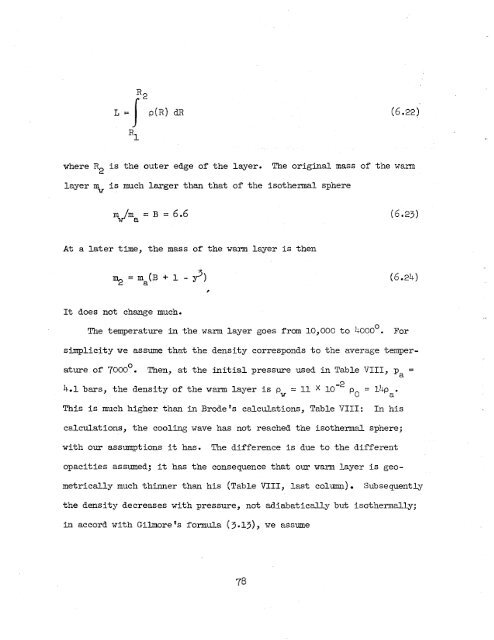Theory of the Fireball
Theory of the Fireball
Theory of the Fireball
You also want an ePaper? Increase the reach of your titles
YUMPU automatically turns print PDFs into web optimized ePapers that Google loves.
where Re is <strong>the</strong> outer edge <strong>of</strong> <strong>the</strong> layer. The original mass <strong>of</strong> <strong>the</strong> warm<br />
layer m is much larger than that <strong>of</strong> <strong>the</strong> iso<strong>the</strong>rmal spnere<br />
W<br />
At a later time, <strong>the</strong> mass <strong>of</strong> <strong>the</strong> warm layer is <strong>the</strong>n<br />
It does not change much.<br />
(6.24)<br />
Tne tepperature in t'ne warn layer goes from 10,000 to l;OOOo, For<br />
simplicity we assume that <strong>the</strong> density corresponds to <strong>the</strong> average temper-<br />
ature <strong>of</strong> 7O0Oo. Then, at <strong>the</strong> initial pressure used in Table VI11 Y Pa -<br />
4.1 bars, <strong>the</strong> density <strong>of</strong> <strong>the</strong> warm layer is p = 11 X<br />
W Po = 14Pa.<br />
This is much higher t'nan in Brode's calculations, Table VIII: In his<br />
calculations, <strong>the</strong> cooling wave has not reached tne iso<strong>the</strong>rmal sphere;<br />
with our assumptions it has, The difference is due to <strong>the</strong> different<br />
opacities assumed; it has <strong>the</strong> consequence that our warm layer is geo-<br />
metrically much thinner than his (Table VIII, last column) Subsequently<br />
<strong>the</strong> density decreases with pressure, not adiabatically but iso<strong>the</strong>rmally;<br />
in accord with Gilmore *s fornula (3.131, we assume
















